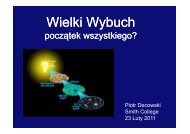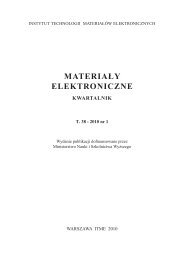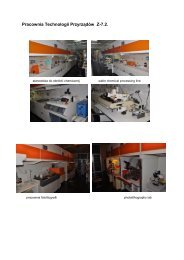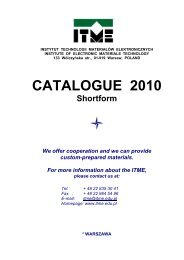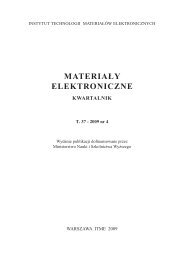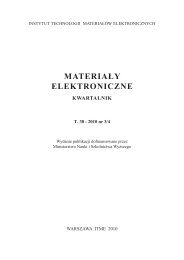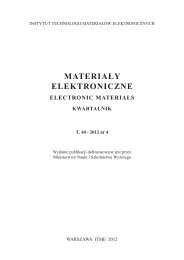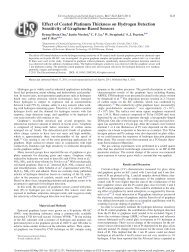Nr 1 - ITME
Nr 1 - ITME
Nr 1 - ITME
Create successful ePaper yourself
Turn your PDF publications into a flip-book with our unique Google optimized e-Paper software.
Potentialities of modification of metal oxide varistor microstructures<br />
PL ISSN 0209-0058 MATERIAŁY ELEKTRONICZNE T. 37 - 2009 NR 1<br />
POTENTIALITIES OF MODIFICATION OF METAL<br />
OXIDE VARISTOR MICROSTRUCTURES *<br />
Witold Mielcarek 1 , Krystyna Prociów 1 , Joanna Warycha 1<br />
The electrical properties of varistors, similarly like posistors and other devices made of<br />
semiconducting ceramic, are controlled by grain boundaries. In varistor conductivity<br />
the main role play potential barriers which arise at grain boundaries during varistor<br />
sintering. The I-V behavior of varistor ceramic is such that during conduction the<br />
varistor voltage remains relatively constant while a current changes are of several<br />
orders of magnitude.<br />
Varistor is produced by sintering a mixture of ZnO with a small addition of Bi 2<br />
O 3<br />
and<br />
other metal oxides. Varistor microstructure composes of ZnO grains. Each ZnO grain<br />
acts as it has a semiconducting junction at the grain boundary. The non-linear electrical<br />
behavior occurs at the boundary of each ZnO grain. The junctions between grains are<br />
separated by an intergranular phase. The best varistor performance is attained when<br />
the Bi-rich intergranular layer is of nanometer size. When the intergranular phase is<br />
in a shape of agglomerates embedding Bi 2<br />
O 3<br />
crystal phases and spinel grains it forms<br />
areas excluded from conduction. The problem has been studied with emphasis on<br />
determining the relation between ZnO dopants and microstructure evolution. It was<br />
established that the vulnerability of varistor ceramic for formation of agglomerates<br />
depend on the composition of additive oxides. With SrO, MnO and PbO varistor<br />
ceramic is more susceptible for formation of agglomerates, while Co 2<br />
O 3<br />
, Sb 2<br />
O 3<br />
and<br />
SnO 2<br />
facilitates the homogenous distribution of additives in varistor body. Elimination<br />
of an electrically inactive areas from varistor body would enable the decrease of the<br />
amount of additives (e.g. the amount of Bi 2<br />
O 3<br />
would decrease from 1 mol % to 0.2<br />
mol %) and bring about the diminishment of the cost of varistor processing along with<br />
improvement of varistor performance.<br />
1)<br />
Electrotechnical Institute, ul. M. Skłodowskiej-Curie 55/61, 50-369 Wrocław, Poland<br />
*<br />
Praca prezentowana na XXXII International Conference of IMAPS - CPMP IEEE,<br />
86<br />
Keywords: ZnO varistor, microstructure, semiconducting ceramic, doping, Bi 2<br />
O 3<br />
Poland, Pułtusk, 21-24.09.2008




